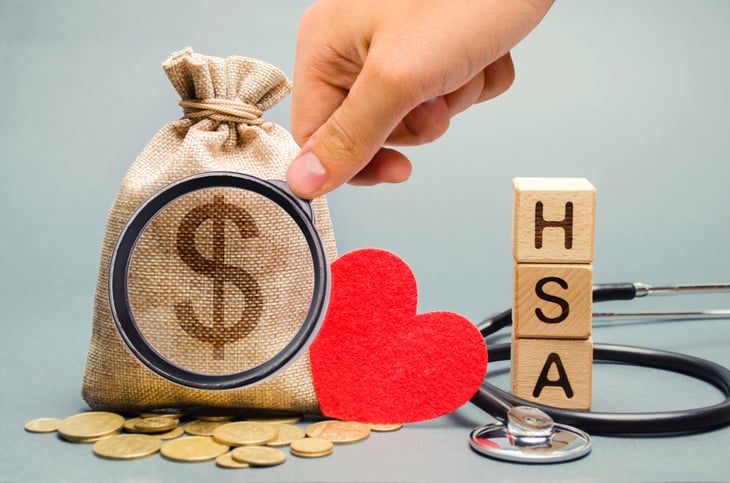
Editor's Note: This story originally appeared on SmartAsset.com.
Older Americans have the opportunity to be healthier and wealthier, but an unsavvy financial tendency is ailing them.
A large percentage of American seniors who are saving to cover health care expenses are skipping the tax-advantaged ways to accumulate such funds, a study has found.
Researchers at the University of Michigan surveyed more than 2,000 people ages 50 to 80 on whether they were saving for medical care and, if so, how. The results indicate many older Americans aren’t saving for health care expenses at all.
Almost as concerning, though, was the survey’s discovery that among those who are saving, many are not employing tax-efficient ways to do so.
Choosing to Not Get Health Care

In January 2021, the University of Michigan National Poll on Healthy Aging surveyed a national sample of more than 2,000 adults, ages 50 to 80, about concerns they had during 2020 regarding affording needed health care in the future and their saving for health care.
The survey found that 13% delayed seeking medical care because of their worry about the cost, 12% needed medical care but did not get it because they could not afford it and 15% had problems paying medical, dental or other health care bills.
Furthermore, they were pessimistic about the future: 18% were not at all confident they would have enough money to pay for health care expenses in the next year.
Among the 71% of adults surveyed who had not put aside money to pay for health care in the past 12 months, 40% said they already had enough savings to pay for health care they might need.
More than 1 in 4 who had not saved said it was because they could not afford to. Other less common reasons were not needing any health care services (18%) and not having thought about it (13%).
Fewer than 1 in 3 adults (29%) reported that in the past 12 months they had put aside money to pay for health care expenses before they needed it. The savers put money aside in several ways.
Following are ways to stretch your health care spending.
Health Savings Accounts

The study found that only 5% of adults had put money in health savings accounts (HSAs) before they needed it. An HSA, which must be paired with a high-deductible health plan, lets you invest for future medical expenses while enjoying special tax breaks.
Your contributions, which are pre-tax, reduce your taxable income and your money grows tax-free. Also, your withdrawals are tax-free as long as you use the money on qualified medical expenses.
Since an HSA is yours and not your employer’s, any unused funds in the account are yours to keep, and that money continues to grow tax-deferred.
The IRS sets HSA contribution limits each year, but these are typically high. For 2021, the maximum HSA contribution is $3,600 for a self-directed plan or $7,200 for a family plan. But if you’re at least 55, you can make an additional catch-up contribution of $1,000 into your account.
For 2022, the maximum HSA contribution is higher: $3,650 for a self-directed plan or $7,300 for a family plan. The catch-up contribution limit for those 55 or older remains at $1,000 in 2022.
Flexible Spending Accounts

The study also found that just 9% of survey respondents said they had put money into flexible spending accounts (FSAs) before they needed medical care. FSAs are employer-provided accounts and do not require a high-deductible health plan, so you can pair it with a low-deductible health plan.
Employers may contribute to these accounts but aren’t required to. These plans can be used to cover co-payments, deductibles, some drugs and various other out-of-pocket medical and dental costs.
You don’t pay taxes on contributions, which means you’ll save an amount equal to the taxes you would have paid on the money you set aside.
Even though FSAs are employer-provided you may roll over up to $550 of unused funds into the following year or be granted a 2.5-month grace period in which to use the money in the following year.
In order to get an FSA you must sign up during your employer’s annual open enrollment period, typically in the fall. Unlike HSAs, your FSA contributions don’t earn interest, and because these plans are employer-provided, you lose these accounts if you leave your job.
The contribution limit of medical FSAs (which differ from dependent care FSAs) for 2021 and 2022 is $2,750 per person, the same as it was for 2020. For married couples, each spouse can put up to $2,750 in their FSAs accounts.
Health Reimbursement Accounts

Just 5% of adults age 50 to 80 reported having a health reimbursement account (HRA). These are employer-funded group health plans from which employees are reimbursed – tax-free – for qualified medical expenses up to a fixed dollar amount per year.
Employers claim a tax deduction for the reimbursements they make through HRAs. Even though you don’t need to pair an HRA with a high-deductible health insurance plan, you still have to link it with a group health plan as determined by your employer.
Unused amounts may be rolled over to be used in subsequent years.
Unlike HSAs, funds in HRAs are owned by the employer, who decides how much to fund employees’ HRAs. If you leave an employer who sponsors an HRA, the employer keeps the money in the account.
Bank Accounts

Bank accounts were used by 19% of adults surveyed.
Bank accounts do not offer the tax advantages that HSAs, FSAs, and HRAs do, and yet they are much more popular among Americans socking away money for health care.
Who Is Putting Money Aside for Health Care Expenses?

Having saved for health care in one of these above accounts in the last 12 months was more common among individuals ages 50 to 64 compared with those ages 65 to 80 (34% versus 22%).
More-educated people also tended to save for health care at higher rates: Individuals with at least a bachelor’s degree were more likely to have saved for health care in one of these accounts in the last 12 months compared with those with a high school education or less (38% versus 22%).
In addition, individuals with an annual household income of at least $100,000 compared with one of less than $30,000 (39% versus 19%) were more likely to save for health care expenses.
Among those who put money aside for health care in HSAs, FSAs, HRAs and bank accounts in the past 12 months, 44% saved $2,000 or more, 18% saved $1,000 to $1,999 and 24% saved less than $1,000.
Those saving for health care in mere bank accounts forfeit the opportunity to take advantage of the tax advantages that HSAs, FSAs and HRAs offer.
The Bottom Line

A large number of Americans ages 50 to 80 have not been saving for health care expenses. Not only that, but many of those who have been saving are not doing so in a tax-efficient way by using HSAs, FSAs and HRAs.
Those who are saving in a tax-efficient manner tend to be wealthier, healthier and better educated than those who aren’t.
As health insurance plans ask people to pay for more of their health care out of their own pockets, such as through high deductibles, these tax-advantaged accounts can help people avoid having to choose between getting health care and not getting it.





Add a Comment
Our Policy: We welcome relevant and respectful comments in order to foster healthy and informative discussions. All other comments may be removed. Comments with links are automatically held for moderation.